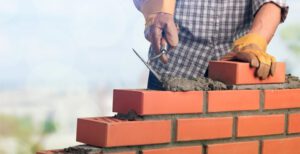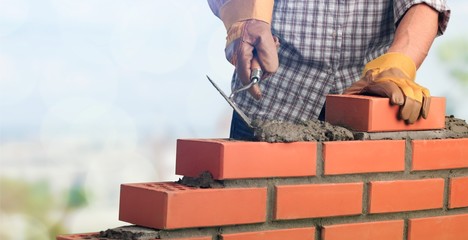Colorado Springs Masonry are an art form that requires specialized skills and training. Through lectures, demonstrations, and campus work projects, students prepare to enter the residential-commercial masonry industry as journeyman masons or as job site foremen.
Most masonry construction requires stable foundations to support the masonry above. Masonry footings are generally concrete structures, although beds of compacted gravel can be used as well.
Brick is a construction material made of clay and usually red or brown in color. Bricks are rectangular building units joined by mortar (larger building units are called blocks). Bricks can be used in various ways, including making walls and paving surfaces. There are several types of brick, and the quality of a brick can be assessed by its color, shape, and texture. Bricks are often fired in kilns, which are a type of furnace designed to heat them rapidly and evenly. This process increases their strength, durability, and resistance to water damage.
The masonry industry uses different methods of making bricks, including extrusion, molding, dry pressing, and chemical setting. These methods vary in how the clay mix is shaped and how it’s burned in a kiln. Some techniques also involve adding limestone, sand, or fly ash to the mix. Many people prefer to use sand-lime bricks, which contain a higher percentage of sand and less clay than traditional bricks. These are cheaper and easier to manufacture, although they may not last as long as other types of brick.
There are many different types of brick bonds, which determine how bricks interlock with each other. Most brick bonds require that bricks be of the same size or at least compatible sizes. This creates a uniform pattern that can be repeated over a large area.
Some common brick bonds include header bonds, stretcher bonds, and herringbone bonds. Herringbone bonds are decorative, not structural, and they produce a distinctive offset herringbone pattern. Header bonds are similar to stretcher bonds, but they use the bricks’ shorter header faces instead of their longer face sides.
Bricks should be checked for quality before being used in a masonry project. If the bricks are not cured, they can shrink when wet, which causes fissures in the mortar between them. They can also draw or absorb too much moisture, which will cause them to swell and lose their color. The color of a brick should be bright and even, and the bricks should be free of cracks and other damage. They should not absorb more than 20% of their weight when soaked in water, and they should not develop the white patch known as efflorescence, which occurs when salts leach from the bricks and crystallize on the surface.
Stone
Stone masons cut long pieces of solid rock into specific shapes and sizes to create sturdy buildings, art sculptures, and monuments. Stone masons use a variety of rock types, including rugged igneous stones like granite and slate, metamorphic rocks that have been transformed by heat and pressure, and sedimentary rocks such as limestone and sandstone.
Because stone is so durable, it stands up well to the elements and can withstand tremendous pressure without damage. In fact, it’s one of the strongest building materials available, with a typical compressive strength of 104.9 MPa (millions of pounds per square inch).
As well as providing structural support, stone is also used for decoration in masonry. Stone can add a unique aesthetic to buildings, with different textures and colors adding to the overall look. It is also a popular choice for paving slabs and walkways, where it can be carved into intricate patterns and designs.
The first stage of stone masonry is the preparation of the site, which includes removing any debris or vegetation and ensuring the area is level. The next step is to prepare the bed for the stone, which includes laying a thin layer of mortar. The masons then place the first course of stones, which should be level and even in height. The stones are then bonded together with the mortar. Any gaps between the stones should be filled with smaller stones. This helps prevent the buildup of tensile stress in the stone masonry.
After the masonry is completed, it should be allowed to cure. This process takes about two weeks and allows the mortar to set properly. During this time, the structure should be checked for any defects. This can be done by using a plumb bob or other testing equipment.
Stone masonry can be very expensive, but it provides excellent durability. Unlike concrete, which can crack and break if it is stressed too much, stone can withstand huge amounts of pressure. It is also a good choice for structures that will be exposed to extreme weather conditions, such as snow or rain.
Concrete
Concrete is a key component in modern masonry. It’s used in foundations, footings, and slabs for floors, walls, and parking garages. It’s also an important ingredient in cement block masonry, where it adds strength and durability to the blocks. Concrete masonry is less expensive than brick masonry and can be built in a much more rapid manner. Concrete masonry structures also have a higher resistance to fire and are typically less prone to seismic damage.
Like brick and stone, concrete masonry is a durable material that can be used in a variety of applications and designs. It is also environmentally friendly, as it can include recycled materials and be manufactured within a local area or shipped short distances to a construction site. These aspects often contribute toward credits in green rating systems.
Both brick and concrete masonry offer energy efficiency benefits for buildings as they help moderate indoor temperature changes. They can also be insulated for enhanced thermal performance. Masonry is also soundproof, which can be beneficial for office or industrial spaces located near railroad tracks or busy streets.
For all types of masonry construction, it’s important to use the right materials and understand how to construct them properly to achieve the desired results. Using the wrong materials can weaken or destabilize a structure, and using incorrect construction methods can result in structural defects and health hazards for workers.
A great resource for learning about concrete and masonry is the US Army Concrete and Masonry Field Manual, or FM 5-428. This 323-page guide offers a basic overview of the construction process and a detailed description of the proper techniques for working with masonry materials.
Masonry construction involves a lot of mixing and hand-laying of units, which can lead to health risks for workers. For example, inhaling silica dust while cutting and shaping masonry can irritate the nose, throat, and lungs. Additionally, using electric tools that are not properly maintained and connected to ground fault protection exposes workers to the risk of shock and electrocution. These safety hazards are reduced with proper training, the use of personal protective equipment, and the implementation of construction practices that protect workers from exposures while ensuring the integrity of the final building.
Masonry Materials
Masonry is constructed from a variety of materials that contribute to the overall strength and appearance of a building. Units, mortars, grout, and steel all work together to provide strength, durability, fire resistance, sound attenuation, and energy efficiency. Masonry units are available in a wide array of sizes, shapes, colors, textures, and profiles to achieve any desired aesthetic or functional characteristics. The most common masonry unit is the concrete block, which offers standardized sizes and mechanical properties. Concrete masonry units can be combined to form walls using a variety of construction techniques.
Brick masonry units are easy to handle, light in weight (lower dead loads), and less expensive than stone or concrete blocks. They are also flexible, allowing for the creation of openings in walls for doors and windows without raising construction costs. The flexibility of brick masonry allows it to be adapted to a wide range of structural requirements, and the units can be joined together with various types of mortars.
When used in conjunction with cement plaster, known as stucco, brick masonry is an attractive and durable building material. Portland cement plaster provides a high-quality surface finish that enhances the beauty of masonry and protects it from weather damage. Like mortar, Portland cement plaster can be tinted to match any color scheme or design.
Manufactured stone veneers are a popular alternative to natural stone and can be constructed from concrete or a mix of aggregate, colorfast pigments, and molds. Manufactured stone can be so realistic that, to the casual observer, there may be no discernible difference between it and real rock.
The grout that fills in between masonry units is another essential component of a masonry structure. Unlike mortar, grout is much softer and allows the stones to blend together more naturally. It is also easy to dye, giving masons the freedom to create unique masonry structures.
Although not technically a masonry material, rebar is a common addition to masonry structures to add reinforcement and support. While it does not belong to any specific category of masonry, it is an important component in many projects because it strengthens the concrete and helps ensure that your finished project holds up to years of wear and tear.
